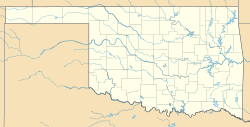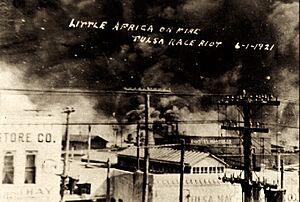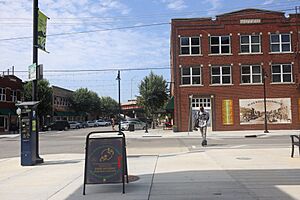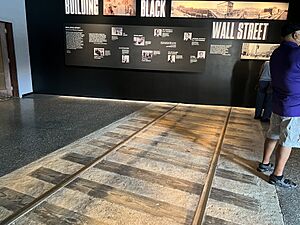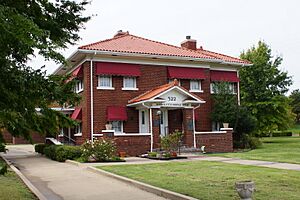Greenwood District, Tulsa facts for kids
Quick facts for kids
Greenwood, Tulsa
|
|
|---|---|
|
Neighborhood
|
|
| Nickname(s):
Black Wall Street
|
|
| Country | United States |
| State | Oklahoma |
| County | Tulsa County |
| City | Tulsa |
Greenwood is a special neighborhood in Tulsa, Oklahoma. It was once a "freedom colony," a place where African Americans could live and build their own communities away from the strict rules of segregation. In the early 1900s, Greenwood became famous as "Black Wall Street" because it had so many successful African-American businesses.
Sadly, in 1921, a violent mob attacked and burned Greenwood to the ground. This terrible event is known as the Tulsa race massacre. Many Black Americans were killed or hurt, and thousands lost their homes. It was one of the worst acts of racial violence in U.S. history.
Even after this tragedy, the people of Greenwood worked hard to rebuild their community within ten years. They faced many challenges, including opposition from white leaders and unfair laws. Greenwood continued to be a strong Black community until the 1950s and 1960s. At that time, new laws ended segregation, allowing Black citizens to live and shop anywhere in the city. This change, while good for equality, also meant Greenwood lost some of its unique energy. Today, city leaders are working to bring new life and development to the area.
Contents
History of Greenwood
How Greenwood Started
Many African Americans came to Oklahoma during the time of the Native American removal. Some were enslaved people who were forced to move with Native American tribes. Others came later, hoping to find land and build a better life. They wanted to escape the harsh rules of Jim Crow laws, which enforced segregation and discrimination against Black people. Oklahoma offered a chance for a new beginning, free from the racism they faced elsewhere. They traveled by wagons, horses, trains, and even on foot to reach this new land.
Many settlers were related to Native Americans who had walked the Trail of Tears. Others were descendants of people who had found safety in Indian Territory. Many Black residents were also part of tribes like the Creeks and Seminoles.
White people in Tulsa used to call the area north of the railroad tracks "Little Africa." In 1905, Booker T. Washington, a famous Black leader, visited the successful Black-owned businesses there. He encouraged residents to keep building and working together. He believed this would help them become strong and independent. Washington had helped create a similar Black-owned district in Alabama called Greenwood. The Tulsa community officially became "Greenwood" in 1906. By 1921, about 10,000 Black residents lived there.
Greenwood Avenue was very important because it ran through the heart of the Black community. It was one of the few streets that didn't cross into white neighborhoods. This street was home to many thriving Black businesses, including grocery stores, banks, and libraries. This success made Greenwood one of the wealthiest African-American communities in the country, earning it the nickname "Black Wall Street."
O. W. Gurley's Role
Around the early 1900s, O. W. Gurley, a wealthy Black landowner from Arkansas, came to Oklahoma. He bought 40 acres of land in Tulsa that he planned to sell only to Black people.
In 1906, Gurley moved to Tulsa. One of his first businesses was a rooming house near the railroad tracks. This road became Greenwood Avenue, named after a city in Mississippi. Many Black people escaping harsh treatment in the South found safety in Gurley's building.
Gurley also built other buildings and homes. He helped start the Vernon AME Church, a Black Masonic lodge, and an employment agency. He helped set the boundaries for Greenwood, which were Pine Street to the north, Archer Street and the Frisco tracks to the south, Cincinnati Street on the west, and Lansing Street on the east.
Another Black entrepreneur, J.B. Stradford, arrived in Tulsa in 1899. He believed Black people could achieve more if they worked together and supported each other's businesses. He bought large areas of land in northeastern Tulsa and sold them only to other Black people. Gurley and others followed his lead. Stradford later built the Stradford Hotel on Greenwood. It was said to be the largest Black-owned hotel in the United States.
By 1921, Gurley owned over 100 properties in Greenwood. His wealth was estimated to be between $500,000 and $1 million, which would be millions of dollars today. Sadly, during the 1921 massacre, all of Gurley's businesses and properties were destroyed. He later moved to Los Angeles, California.
The Rise of Black Wall Street
The Greenwood district became known as "Black Wall Street" because it was a very successful and wealthy African-American community. Many African Americans moved to Oklahoma hoping to find economic opportunities, especially in the oil industry. Even though Black people were a small part of Oklahoma's population, their numbers grew a lot in Tulsa during the oil boom.
During the Jim Crow era, Black Americans were often not allowed to shop or get services in white areas. Oklahoma had some of the strictest Jim Crow laws. This forced many Black Americans to spend their money within their own community. This helped Greenwood's businesses grow and thrive.
On "Black Wall Street," there were Black attorneys, real estate agents, business owners, and doctors. J.B. Stradford, for example, bought empty land and sold it to Black residents for homes and businesses. By 1921, he was one of the wealthiest Black Americans. There were also many barbershops, grocery stores, and even a funeral home. Greenwood was also a strong religious community with many Black-owned churches.
The 1921 Massacre
Many white residents felt threatened by Greenwood's success and growth. They were resentful of the wealth in the Black community. The Tulsa race massacre of 1921 began when a Black shoe shiner was falsely accused of assaulting a white woman. This event sparked the terrible violence that destroyed Greenwood.
Rebuilding and Legacy
After the massacre, many residents promised to rebuild. Within ten years, they had rebuilt much of the district. They did this despite opposition from white leaders and unfair laws meant to stop them. By 1941, there were over 240 Black businesses in Greenwood.
Greenwood remained a strong Black community until the 1950s and 1960s. When segregation ended, Black citizens could live and shop anywhere. This caused Greenwood to lose some of its original energy. City leaders have since tried to encourage new development.
In 1996, a group was formed to study how to help the victims and their families from the 1921 massacre. In 2001, they suggested that survivors and their families should receive payments for the damage.
More recently, some people in the Greenwood District have called for the removal of the I-244 highway. They believe it has harmed the community as much as the 1921 massacre did.
Greenwood Historic District
The Greenwood Historic District in Tulsa is a special area. It is bounded by the Crosstown Expressway (I-244) to the north, Elgin Avenue to the west, Greenwood Avenue to the east, and the Frisco tracks to the south. In 2022, the Greenwood Historic District was added to the National Register of Historic Places.
In 2023, a bill was introduced in the U.S. Senate to create a National Monument called the Historic Greenwood District—Black Wall Street.
Landmarks in Greenwood
Greenwood Rising History Center
The Greenwood Rising History Center opened in 2021. It is located at 21 North Greenwood Avenue. This center helps tell the story of Black Wall Street and the massacre.
Greenwood Cultural Center
The Greenwood Cultural Center opened in 1995. It honors Greenwood's history and offers hope for the future. It has a museum, an African American art gallery, and a large hall. The center helps rebuild and unite the Greenwood Historic District.
The center promotes education and cultural events about African American heritage. It also helps people see North Tulsa in a positive way. In 2011, the center lost its state funding, but the community and the Cherokee Nation helped it continue. In 2021, President Biden visited the center during the 100-year anniversary of the 1921 Tulsa Race Massacre.
John Hope Franklin Reconciliation Park
Work began in 2008 on Reconciliation Park to remember the 1921 Tulsa Race Massacre. John Hope Franklin, a famous historian, attended the groundbreaking. After he passed away in 2009, the park was renamed John Hope Franklin Reconciliation Park. It has sculptures and informational plaques. It is a place for learning and quiet reflection.
The park was first funded by the State of Oklahoma, the City of Tulsa, and private donations. Now, the city owns it, and a nonprofit organization manages it.
Notable People from Greenwood
- Viola Fletcher, a survivor of the Tulsa race massacre
- The Gap Band, a famous R&B music group


